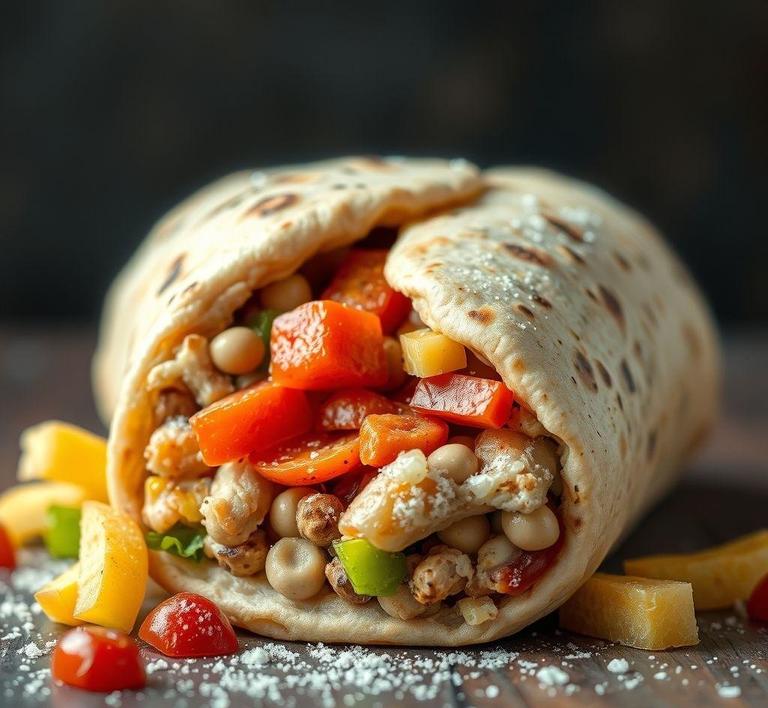If you’ve ever found yourself with a leftover burrito and wondered if it’s possible to refreeze it for later, you’re not alone! While freezing burritos is a great way to preserve them, refreezing can be a bit tricky. Refreezing a burrito can affect its texture and flavor, but with the right steps, it’s totally doable. Whether you’re dealing with a store-bought burrito or a homemade one, knowing how to properly refreeze it can save you time and prevent waste. In this guide, we’ll walk you through the best practices to keep your burrito tasting fresh and delicious even after a second freeze!
🧊 Can You Refreeze A Burrito?

Yes, you can refreeze a burrito, but whether you should depends on several important factors. The safety and quality of a refrozen burrito hinge on how it was handled during its thawed state.
If a burrito was thawed in the refrigerator and not left out at room temperature for more than two hours (or one hour if the ambient temperature exceeds 90°F/32°C), it is generally safe to refreeze. This is because refrigeration slows bacterial growth, keeping the food within a safe temperature zone (below 40°F or 4°C). However, if the burrito was thawed on the countertop or left out in a lunchbox for half the day, refreezing it could increase the risk of foodborne illness due to potential bacterial contamination.
Another key consideration is the burrito’s contents. Burritos made with cooked meats, beans, rice, cheese, and vegetables are all susceptible to textural and flavor degradation after being thawed and refrozen. So while refreezing is safe under the right conditions, it may come at a culinary cost.
🌀 How To Refreeze A Burrito (Properly)
Refreezing a burrito isn’t just about tossing it back into the freezer. To preserve as much quality and safety as possible, follow this step-by-step guide:
-
🧊 Ensure Proper Thawing:
Only refreeze a burrito that was thawed in the refrigerator. Never refreeze a burrito that has been reheated or left at room temperature for more than two hours.
-
🧼 Check for Signs of Spoilage:
Before refreezing, examine the burrito. If there’s an off smell, discoloration, or slimy texture, it’s best to discard it. Don’t take risks with questionable food.
-
🧻 Wrap It Right:
Moisture is your enemy when freezing (and refreezing) burritos. To minimize freezer burn and texture degradation:
- Wrap the burrito tightly in plastic wrap or aluminum foil.
- Place the wrapped burrito in a heavy-duty, air-tight freezer bag.
- Label the package with the date of refreezing.
-
❄️ Freeze Quickly:
Place the burrito in the coldest part of your freezer to ensure rapid refreezing. The quicker it freezes, the better the texture and flavor will hold up.
🧪 Quality Impact: What Happens To The Burrito After Refreezing?
Refreezing food is not without consequence-especially when it comes to burritos, which are a blend of multiple textures and moisture levels. Here’s how refreezing impacts different components:
-
🌮 Tortilla:
The tortilla often suffers the most. Refreezing can make it soggy, tough, or even crumbly after reheating, particularly if it’s a flour tortilla. Moisture from thawed fillings can seep into the tortilla, altering its consistency.
-
🫘 Beans and Rice:
Both of these ingredients are relatively freezer-friendly on their own, but repeated freezing and thawing can cause rice to become dry and mealy. Beans may become mushy or watery, and can contribute to excess moisture during reheating.
-
🧀 Cheese:
Cheese tends to separate and become oily when repeatedly frozen and thawed. While this isn’t unsafe, it can lead to an unappealing texture and flavor.
-
🥩 Meat:
Refrozen meat can lose moisture, resulting in a drier, less flavorful interior. Ground beef or shredded chicken may fare slightly better than steak or larger cuts due to their already tender consistency.
-
🌶️ Vegetables:
Vegetables like peppers, onions, or corn may become limp or watery, especially if they weren’t pre-cooked before freezing.
So while a refrozen burrito won’t necessarily be “bad”, it will likely be different-sometimes noticeably so-in taste and texture.
Yes, you can refreeze a burrito safely-if it was thawed properly in the refrigerator and hasn’t lingered in the temperature danger zone. But the real question isn’t just can you, but should you?
From a safety standpoint, proper refreezing is fine. From a quality standpoint, however, you’re likely to notice some degradation. The tortilla may get soggy, the filling might turn mushy or dry, and the overall experience might not compare to the freshly cooked or even the once-frozen version.
If quality is paramount, consider consuming thawed burritos within a couple of days or freezing them in single-serving sizes to avoid the need for refreezing. But if convenience trumps texture in your book, rest assured that your refrozen burrito, while slightly diminished, is still a worthy and safe snack or meal.
🧊 Is It Safe To Refreeze Burritos?
The short answer: Yes, it can be safe to refreeze burritos-but only under the right conditions.
Refreezing food is a nuanced issue in the world of food safety. Burritos, being complex bundles of ingredients (meat, cheese, beans, rice, vegetables, and tortillas), need particular care. If your burrito was initially cooked, frozen, thawed in the refrigerator, and never sat at room temperature for more than two hours, it is generally safe to refreeze.
However, every layer of the burrito presents a potential risk if not handled properly. For example, cooked meat that has been left out too long can harbor bacteria, while moist components like salsa or sour cream can alter texture and flavor upon refreezing.
Key safety conditions for refreezing:
- The burrito was thawed in the refrigerator (not on the counter).
- It was not left out at room temperature for more than 2 hours (or 1 hour if above 90°F/32°C).
- The burrito has not developed off smells, textures, or colors.
If all boxes are checked, you’re in the clear to refreeze-but keep in mind, while refreezing may be safe, it can impact quality.
🚩 Signs That A Burrito Should Not Be Refrozen
Before you even consider tossing that burrito back into the freezer, you need to give it a thorough inspection. Here are clear red flags that your burrito should not be refrozen-and definitely not eaten:
-
Sour or Off Smell:
If the burrito smells tangy, sulfurous, or just ‘off’ in any way, it’s likely harboring bacterial growth. Trust your nose-it’s often your first and best line of defense.
-
Slimy or Discolored Filling:
A slimy texture on cooked meat, cheese, or vegetables is a clear sign of spoilage. Likewise, if beans have turned grayish or if the cheese has a pink or green hue, toss it.
-
Soggy or Waterlogged Tortilla:
While texture alone isn’t a food safety issue, a tortilla that’s overly soggy may indicate that the burrito has been sitting too long, breaking down from the inside out.
-
Mold:
This one’s non-negotiable. If you see even a speck of mold, especially in moist components like cheese or tortilla, discard the whole thing.
-
Uncertainty:
If you’re unsure how long the burrito has been thawed or whether it’s been kept properly cold, it’s not worth the gamble. Foodborne illness isn’t worth a salvaged snack.
Common Refreezing Mistakes
Even well-meaning home cooks can unknowingly reduce the safety or quality of their burritos through common mishaps. Here’s what to avoid:
-
Thawing on the Counter:
This is the cardinal sin of refreezing. Leaving a burrito on the kitchen counter to thaw can expose it to the ‘danger zone’ (40°F-140°F) where bacteria thrive.
-
Repeated Thaw-Refreeze Cycles:
Every time a burrito is thawed and refrozen, its structure and safety are compromised. Moisture is lost, textures break down, and bacteria can multiply if not handled swiftly.
-
Freezing Without Wrapping Properly:
A poorly wrapped burrito will suffer from freezer burn, which dries out the tortilla and ruins the flavor. This isn’t just a quality issue-it can accelerate spoilage.
-
Refreezing After Microwaving:
If you reheated the burrito but didn’t finish it, it’s no longer safe to refreeze. Once food has been heated to serving temperature (above 165°F), it should be eaten or discarded, not re-cooled and re-frozen.
🧠 Tips And Tricks For Safe Refreezing
If you’re planning to refreeze a burrito or want to be strategic in how you store them in the first place, here are some expert tips:
-
Freeze in Portions:
Don’t freeze a whole batch in one lump. Wrap each burrito individually in foil or freezer-safe plastic wrap, then place them in a freezer bag. This makes it easy to thaw only what you need.
-
Label Everything:
Write the freeze date on the packaging. Try to use refrozen burritos within 1 month for best texture and flavor, even if they are technically safe for up to 3 months.
-
Avoid High-Moisture Fillings:
If you’re meal prepping, keep fresh tomatoes, sour cream, or guacamole out of the burrito before freezing. Add those after reheating for a better texture and taste.
-
Rapid Freeze:
Place fresh burritos on a metal tray in a single layer in the coldest part of your freezer. The faster they freeze, the less ice-crystal damage they’ll suffer.
-
Thaw Properly:
Always thaw frozen burritos in the refrigerator. Never leave them on the counter. You can also reheat them directly from frozen-just increase the microwave or oven time accordingly.
Conclusion
In the grand dance of food safety and culinary convenience, refreezing burritos can be a lifesaver-if done properly. It’s not just about tossing something back in the freezer. It’s about knowing where your food’s been, how it’s been handled, and whether it’s passed the point of no return.
Refreezing is safe only when the burrito has remained within safe temperature zones, hasn’t shown signs of spoilage, and hasn’t already been reheated. Avoid common mistakes, handle with care, and you can safely enjoy that extra burrito another day without compromising flavor, texture, or your health.

